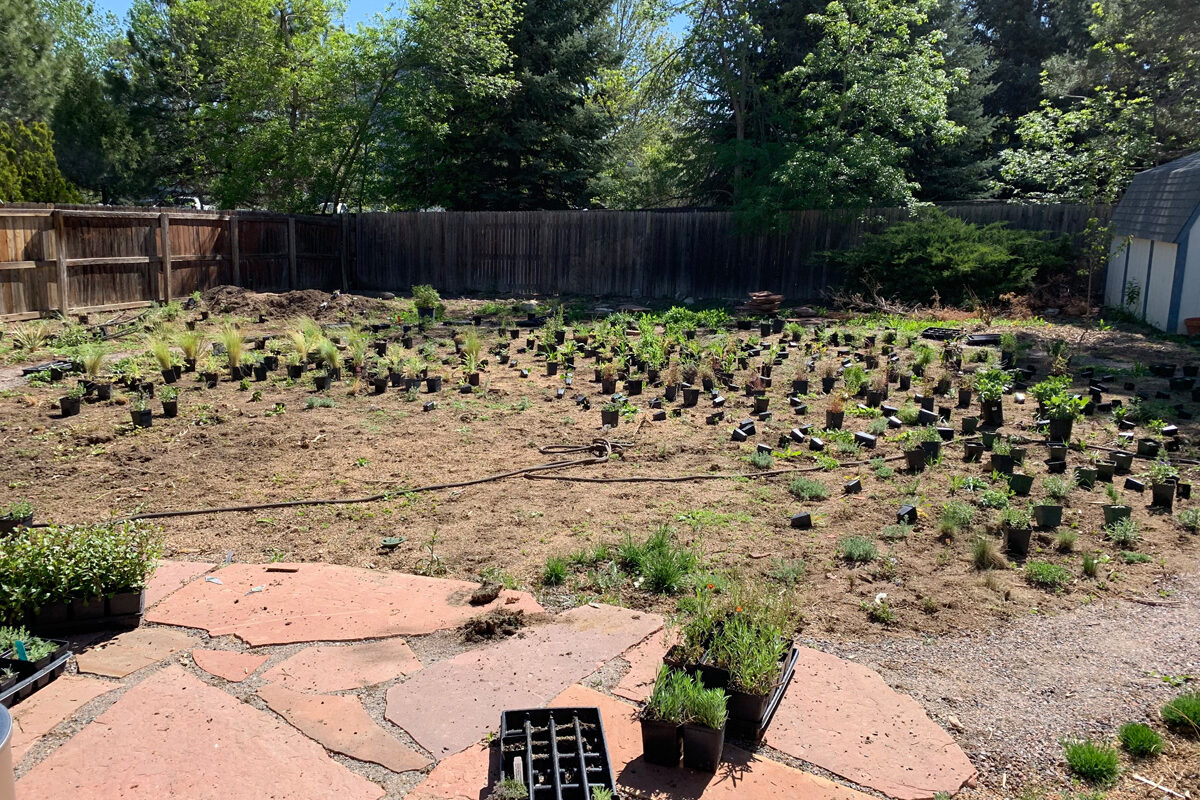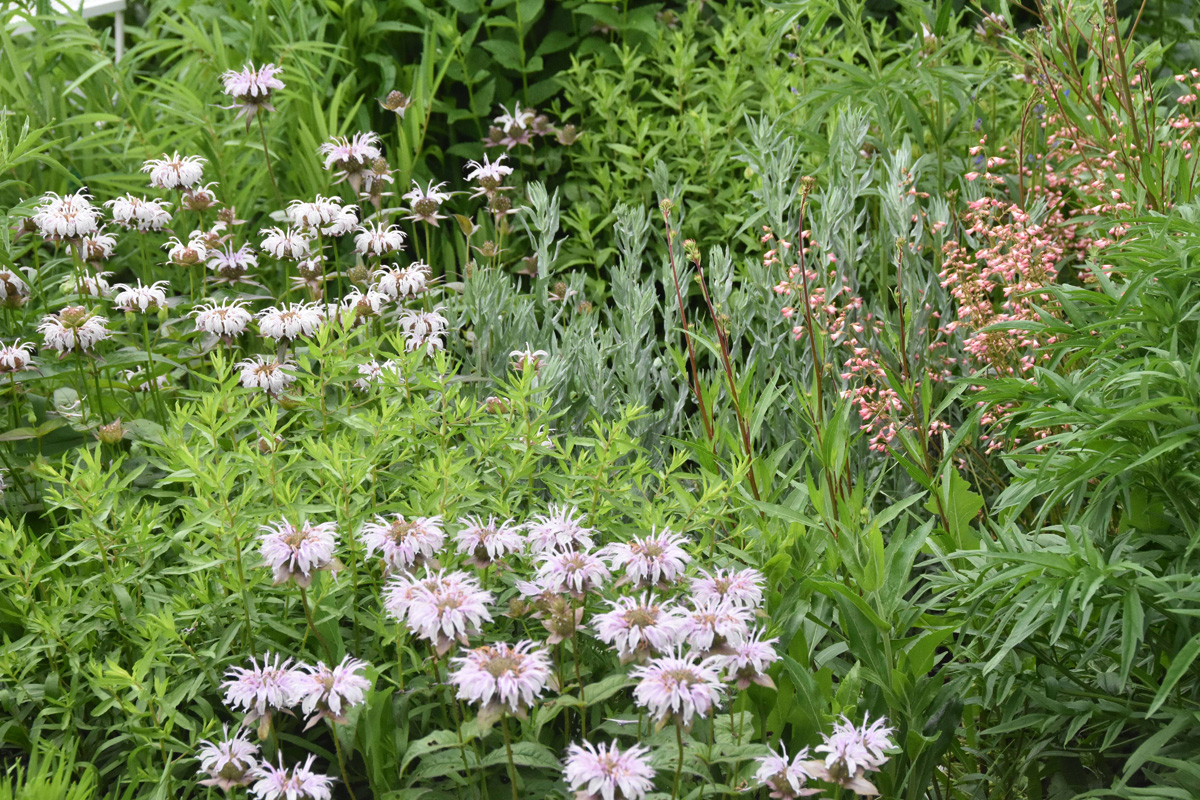
I’ve designed, installed, and continue to manage two meadow lawns to date. Through these gardens, as well as my own study in nature and research in references, I’ve learned a lot about what makes an effective meadow garden over the last few years.
The first meadow garden I designed was the ½-acre Prairie Garden at the Gardens on Spring Creek. This garden has recently drawn attention for its inclusion in Claire Takacs and Giacomo Guzzon’s wonderful new book “Visionary: Gardens and Landscapes for our Future.”
Then in 2021, I turned my lawn into a meadow, with complementary flanking beds. The meadow is certainly the main feature of my home yard and is constantly changing, both as things come into and out of interest—whether that be bloom, seed heads, or interesting foliage—and as I change the design to suit my tastes. A substantive, rose flagstone patio, about two-thirds of which my brother kindly helped me lay, acts as a sort of interface for plants and people between the house and the meadow. With the quarry twenty minutes away, the stone is easy to come by in my area for a fair price. It makes for an attractive, warm-toned living space comprised of quickly legible, geometric shapes that contrasts well with busy, flowing, green to tawny meadow vignettes.
 |
 |
Below, I’ll distill three of the crucial concepts for beginner meadow gardeners I have learned through the planning, installation, and reassessing of the gardens above. These tips include one for the hardscape design, one for the planting design and management, and one for the installation. Hopefully this will assist you in designing your very own meadow lawn or garden.

1 | Frame your meadow with hardscape
When you are laying out your garden’s perimeter, keep in mind that it is easier to install hardscape at the start rather than trying to add it later. Meadows are inherently busy gardens and benefit greatly from breaks in the sight line. Plants mix and mingle, and if the garden isn’t edited each year, they can become chaotic, lending themselves to the “green blob” effect. Adding a hardscape frame to the meadow can immediately make the garden more legible and cohesive, which is ideal for those just learning to execute this style. My home meadow is framed, for example, by my rose flagstone patio and crusher fine paths, while the one at The Gardens on Spring Creek is framed by a concrete walkway. If a frame isn’t possible or realistic, ensuring your meadow contains a less-busy area, ideally one near the center or adjacent to the “human spaces,” can serve the same purpose. Given the intensity of my home meadow, I opted for both of these strategies, pairing my visual frame patio (learn how to build a patio in a weekend) with a low-growing buffalograss lawn that blends seamlessly into taller meadow vignettes as it moves farther from the patio. Since buffalograss abhors shade, it never enters the taller meadow design, which shades the ground, and is thus unable to become a weed.

2 | When picking plants, avoid thugs until you know your site
Garden thugs like running grasses, sedges, and aggressively seeding or running perennials will quickly overwhelm other plants in a design, leaving the gardener frustrated and more likely to throw in the towel. In the beginning, avoid pushy plants altogether, especially heavy seeders and runners. Good examples of plants to avoid would include known thugs like yarrow (Achillea spp. and cvs., Zones 3–9), most milkweeds (Asclepias spp. and cvs., Zones 3–9) except for butterfly weed (Asclepias tuberosa), true mints (Mentha, Zones 2–10), most goldenrods (Solidago spp. and cvs., Zones 3–9), and similar running or colony-forming plants.

Most grasses sold in the horticulture trade are bunching, and work well in such designs, but turfgrasses and many weeds are prodigal runners, making it crucial that all grassy weeds are truly eliminated prior to planting your meadow garden. A small percentage of garden plants are well-behaved garden denizens on some soils and aggressive on others. I’ve found, for example, that stiff goldenrod (Oligoneuron rigidum, Zones 3–9) aggressively reseeds on clay soils in my area but not on sandier soils. The takeaway? Start with a clean slate. As you plan your design, avoid aggressive garden plants, and research or avoid plants that you can’t assess the vigor of. Walk your garden weekly, and learn what your plants and your weeds look like both as seedlings and as mature plants so that you can identify them and manage them when it’s easiest. See: Plants We Wish We Never Planted.

Tip: A rough rule of thumb I’ve begun to use in my garden—if any plant’s garden population increases by more than half in a year, it should be managed (with changes to cultural practices) or removed to ensure it cannot overpower your ecological design.

3 | Plant or seed densely
In nature, most meadow plants grow in communities and according to moisture preference. Applying this concept to the garden reduces labor and increases success, as dense plantings suppress weeds, shade the soil, reduce water loss, and ensure that if one or more plants (or species) flounder, others will take their place. When installing my meadows, I group plants coarsely by general moisture needs and then plant slightly more densely than would be suggested by references or plant labels. I also plant in the smallest pot sizes I can find, such as 2½-inch quarts or even large plugs. Not only do these smaller sizes experience less transplant shock and grow quickly, but installing them is easier on my body. Since flats cost roughly the same regardless of the pot size they contain, buying smaller pots in whole flat quantities also gets me more plants for the money!

In most cases, I also go back and overseed with the same species into my planted stands, raking seeds in and watering daily for a few weeks. If I don’t get a good fill, I’ll scatter seeds on snow the following winter, no raking needed. Ensuring quick canopy coverage dramatically reduces weed pressure in the first couple of seasons for a meadow garden and is worth the extra work. If seeding is not practical, installing a thick mulch—gravel is great for this purpose, though wood mulch works well enough—can help to suppress weeds too. I still hand weed every other week during the first two or three seasons to ensure I wear down the weed seed bank; from years three or four and on, weeding is surprisingly modest barring an unresolved perennial weed problem.
Well-designed meadow gardens are particularly interesting in that they change—and not only do they change with the months and seasons as blooms come and go, they also experience succession and respond to environmental changes as a system. From year to year, as conditions and plant maturity and competition dictate, they evolve.

It’s best to think of such gardens as highly iterative rather than one-time installations. They ask that the gardener predict, act, observe, and respond in a slightly different way with each change the garden experiences. That change could be increased seedling recruitment due to a wet spring (fast), or the maturation and eventual seeding of large, slow-growing, long-lived species (slow) that will shade parts of the garden. Having your boots on the ground and a sense of your soil, garden’s concept, problem plants (weeds included), and goals will make that process a lot easier and more fun! After all, isn’t that why so many of us garden?
See more Mountain West regional reports here.
To discuss these plants or ask other gardening questions, chat with the author on the Gardening Answers forum.
Learn more:
Traditional vs. Stylized Meadow Gardens
Native Annuals and Biennials for the Mountain West
Meadow Garden with Multi-Season Interest
Bryan Fischer lives and gardens at the intersection of the Great Plains and the Rockies. He is a horticulturist and the curator of plant collections for a local botanic garden.
All photos unless otherwise noted: Bryan Fischer
Fine Gardening Recommended Products

Berry & Bird Rabbiting Spade, Trenching Shovel
Fine Gardening receives a commission for items purchased through links on this site, including Amazon Associates and other affiliate advertising programs.

isYoung Birdlook® Smart Bird Feeder with Camera
Fine Gardening receives a commission for items purchased through links on this site, including Amazon Associates and other affiliate advertising programs.

Niteangel Natural Wooden Insect Hotel, Garden Insect House for Ladybugs, lacewings, Butterfly, Bee, Bug
Fine Gardening receives a commission for items purchased through links on this site, including Amazon Associates and other affiliate advertising programs.



















Comments
Log in or create an account to post a comment.
Sign up Log in